|
|
 |
Fiche d'espèce de Copépode |
|
|
Cyclopoida ( Ordre ) |
|
|
|
Corycaeidae ( Famille ) |
|
|
|
Corycaeus ( Genre ) |
|
|
|
Ditrichocorycaeus ( Sous-Genre ) |
|
|
| |
Corycaeus (Ditrichocorycaeus) lubbocki Giesbrecht, 1891 (F,M) | |
| | | | | | | Syn.: | Corycäus lubbocki Giesbrecht, 1891; 1892 (p.660, 674, figs.F);
Corycaeus farrani : Früchtl, 1924 b (p.96, figs.F);
no C. lubbocki : Farran, 1936 a (p.137);
? no C (Ditrichocorycaeus) lubbocki : F. Dahl, 1894 (p.71); M. Dahl, 1912 (p.64, figs.F,M); Dakin & Colefax, 1940 (p.115, figs.M);
Ditrichocorycaeus lubbocki: Dessier, 1983 (p.89, Tableau 1, Rem., %); Binet, 1984 (tab.3); 1985 (p.85, tab.3); Boxshall & Halsey, 2004 (p.495); Vives & Shmeleva, 2010 (p.216, figs.F,M, Rem.); Wi & al., 2013 (p.427, figs.F,M, Rem.) | | | | Ref.: | | | Thompson & Scott, 1903 (p.240, 285); A. Scott, 1909 (p.250, Rem.); Wilson, 1942 a (p.181, no fig.F); Sewell, 1947 (p.279, 281, figs.F, Rem.); Tanaka, 1957 (p.90, Rem.); Chen & al., 1974 (p.59, figs.F); Bradford, 1978 (p.140: Rem.); Zheng & al., 1982 (p.144, figs.F); Al-Yamani & Prusova, 2003 (p.139, figs.F); Al-Yamani & al., 2011 (p.113, 116, figs.F) |  issued from : R.B.S. Sewell in The John Murray Expedition, 1933-34, Scientific Reports, VIII (1), 1947. [p.283, Fig.71]. Female (from S coast of Arabia): A, last thoracic seggment and urosome (lateral right side); B, A2; C, P1; D, P2; E, P3; F, P4. Nota: Proportional lengths of the anterior and posterior regions of the body as 56 to 44. Proportional lengths of the various segments of the body (cephalon to caudal rami) as 364:69:33:47:59:18:153:62:195 = 1000. Head and 1st thoracic segment separate. 3rd thoracic segmenti produced in a long stout spinous process that extends to half the length of the genital segment; 4th is produced backwards and ends in a sharp spine. Genital segment is produced in a rounded eminence at the antero-ventral region, without any spinous projection in this region, such as is described and figured by M. Dahl, but agrees with the figures given by Giesbrecht (1892, fig.57) and Früchtl (1924, fig.72).
|
 issued from : Q.-c Chen & S.-z. Zhang & C.-s. Zhu in Studia Marina Sinica, 1974, 9. [Pl.18, Figs.13-16]. Female (from China Seas): 13, habitus (dorsal); 14, idem (lateral left side); 15, A2; 16, P4.
|
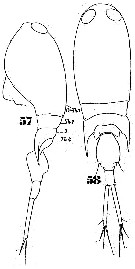 Issued from : W. Giesbrecht in Systematik und Faunistik der Pelagischen Copepoden des Golfes von Neapel und der angrenzenden Meeres-Abschnitte. – Fauna Flora Golf. Neapel, 1892. Atlas von 54 Tafeln. [Taf.51, Figs.57, 58]. As Corycäus lubbockii. Female: 57, habitus (lateral); idem (dorsal).
|
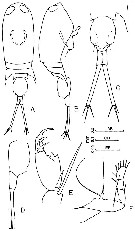 issued from : F.Y. Al-Yamani & I. Prusova in Common Copepods Northwestern Arabian Gulf : Identification Guide. Kuwait Institute for Scientific Research, 2003. [p.138, Fig.53]. Female: A, habitus (dorsal); B, idem (lateralright side); C, urosome (dorsal); D, idem (lateral left side); E, A2; F, P4. Proportional lengths of urosomites and caudal rami 38:17:47. A2 with marginal spine of basipod segment 2 about 3 times shorter than that of basipod 1.
|
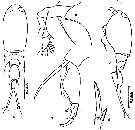 issued from : Z. Zheng, S. Li, S.J. Li & B. Chen inMarine planktonic copepods in Chinese waters. Shanghai Sc. Techn. Press, 1982 [p.144, Fig.90]. Female: a-b, habitus (dorsal and lateral, respectively); c, A2; d, distal spines of exopod of P2; e, P4. Scale bars in mm.
|
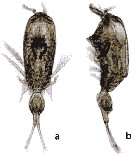 issued from : Y. Al-Yamani, V. Skryabin, A. Gubanova, S. khvorov & I. Prusova in Marine Zooplankton Practical Guide for the Northwestern Arabian Gulf, 2, 2011. [p.116, Fig.264]. Female (from Kuwait): a-b, habitus (dorsal and left lateral, respectively). Nota: Prosome less than twice as long as urosome. Prosome 1.7 times urosome. Genital segment without ventral hook. Caudal rami longer than anal somite.
|
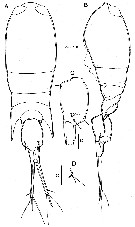 Issued from : J.H. Wi, D.H. Kim & H.Y. Soh Ocean Sci. J., 2013, 48 (4). [p.428, Fig.5]. As Ditrichocorycaeus lubbocki.
Female (from of W Jeju Is.): A-B, habitus (dorsal and lateral, respectively); C, genital double-somite and anal somite (lateral); D, P5.
Scale bars in µm.
|
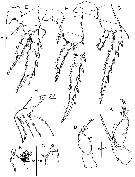 Issued from : J.H. Wi, D.H. Kim & H.Y. Soh Ocean Sci. J., 2013, 48 (4). [p.429, Fig.6]. As Ditrichocorycaeus lubbocki.
Female: A, A2; B, Md; C, Mx1; D, Mxp; E, P1; F, P2; G, P3; H, P4.
Scale bars in µm.
|
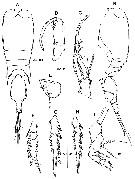 Issued from : J.H. Wi, D.H. Kim & H.Y. Soh Ocean Sci. J., 2013, 48 (4). [p.431, Fig.7]. As Ditrichocorycaeus lubbocki.
Male: A-B, habitus (dorsal and lateral, respectively); C, A2; D, Mxp; E, P6; F, exopod of P1; G, exopod of P2; H, exopod of P3; I, P4.
Scale bars in µm.
| | | | | Ref. compl.: | | | Sewell, 1948 (p.409, 420, 434); C.B. Wilson, 1950 (p.195); Delalo, 1966 (p.72); Kovalev & Shmeleva, 1982 (p.86); Greze & al., 1985 (p.8); Othman & al., 1990 (p.561, 564, Table 1);Shih & Young, 1995 (p.76); Lo & al., 2004 (p.89, tab.1) | | | | NZ: | 8 + 3 douteuses | | |
|
Carte de distribution de Corycaeus (Ditrichocorycaeus) lubbocki par zones géographiques
|
| | | | | | | | | | | | | Loc: | | | Brazil (in C.B. Wilson, 1950), Chesapeake Bay (in Wilson, 1932, p.42), Medit. (Alboran Sea, Ionian Sea), Red Sea, Arabia (S coast), Arabian Sea, Arabian Gulf (Kuwait), Madagascar (Nosy Bé), Sri Lanka, Indonesia-Malaysia, Philippines, Viet-Nam, Hong Kong, China Seas (East China Sea, South China Sea), Taiwan, Mienhua Canyon, S Korea (off W Jeju Is.), off Hawaii, Australia (G. of Carpentaria), New Caledonia, Panama, Bering Sea (in C.B. Wilson, 1950) | | | | N: | 28 | | | | Lg.: | | | (11) F: 1,033; (46) F: 0,95; (109) F: 0,95-0,87; (937) F: 0,93-0,94; (1023) F: 0,75; (1152)* F: 0,98-1,03; M: 0,80-0,82; {F: 0,75-1,03}
* Total body length in lateral view. | | | | Rem.: | La présence de cette espèce dans l'extrême Pacifique nord est étonnante, comme les localisations en Méditerranée, au Brésil et dans la baie de Chesapeake.
Pour Gurney (1927, p.161) cette forme peut être confondue avec C. brehmi .
Voir aussi les remarques en anglais | | | Dernière mise à jour : 02/01/2015 | |
|
|
 Toute utilisation de ce site pour une publication sera mentionnée avec la référence suivante : Toute utilisation de ce site pour une publication sera mentionnée avec la référence suivante :
Razouls C., Desreumaux N., Kouwenberg J. et de Bovée F., 2005-2025. - Biodiversité des Copépodes planctoniques marins (morphologie, répartition géographique et données biologiques). Sorbonne Université, CNRS. Disponible sur http://copepodes.obs-banyuls.fr [Accédé le 21 octobre 2025] © copyright 2005-2025 Sorbonne Université, CNRS
|
|
 |
 |












